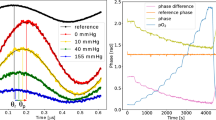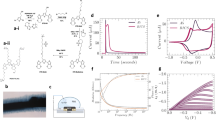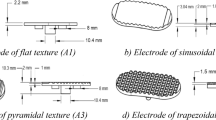Abstract
THE measurement of tissue oxygen tensions in vivo by a polarographic technique using platinum electrodes was described by Davies and Brink1. Since then many different types of electrodes have been used, including membrane-covered electrodes which are unaffected by flow and give good calibration characteristics but are fragile and very large in comparison with cellular dimensions. Such electrodes and their characteristics have been described by Charlton2, Evans and Naylor3,4 and Naylor and Evans5,6. Open-ended electrodes are affected by fluid movement at the exposed tip but they are easy to construct and use and can be made very small and more suitable for insertion into solid tissues. The usual electrode used for tissue pO2 measurements has been bare-ended or collodion-covered gold or platinum electrodes, approximately 200–300µ, diameter7–10. Cater has also used rigid needle electrodes, with fine tips11. However, the tissue trauma caused by the physical act of insertion of such electrodes could probably cause fairly large quantitative errors in pO2 measurements12–14, and thus it was considered of interest to compare tissue pO's registered by electrodes of different dimensions. We had previously used 330µ insulated gold wire to record tissue and tumour pO2 at ambient and raised oxygen tensions in animals13,14. In the present work, pO2 registered by these electrodes were compared with those registered by electrodes made from 60µ gold wire, while animals breathe air or oxygen at 4 or 5 atmospheres.
This is a preview of subscription content, access via your institution
Access options
Subscribe to this journal
Receive 51 print issues and online access
$199.00 per year
only $3.90 per issue
Buy this article
- Purchase on SpringerLink
- Instant access to full article PDF
Prices may be subject to local taxes which are calculated during checkout
Similar content being viewed by others
References
Davies, P. W., and Brink, F., Rev. Sci. Instrum., 13, 524 (1942).
Charlton, G., J. App. Physiol., 16, 729 (1961).
Evans, N. T. S., and Naylor, P. F. D., J. Polarograph. Soc., No. 2, 26 (1960).
Evans, N. T. S., and Naylor, P. F. D., J. Polarograph. Soc., No. 2, 40 (1960).
Naylor, P. F. D., and Evans, N. T. S., J. Polarograph. Soc., No. 2, 33 (1960).
Naylor, P. F. D., and Evans, N. T. S., J. Polarograph. Soc., No. 2, 46 (1960).
Cater, D. B., Phillips, A. F., and Silver, I. A., J. Physiol., 129, 33 (1955).
Cater, D. B., Phillips, A. F., and Silver, I. A., Proc. Roy. Soc., B, 146, 289 (1957).
Cater, D. B., Silver, I. A., and Wilson, G. M., Proc. Roy. Soc., B, 151, 256 (1959).
Bean, J. W., Amer. J. Physiol., 201, 1192 (1961).
Cater, D. B., Garattini, S., Marina, F., and Silver, I. A., Proc. Roy. Soc., B, 155, 958 (1961).
Jamieson, D., J. Coll. Radiol. Austral., 6, 94 (1962).
Jamieson, D., and van den Brenk, H. A. S., Brit. J. Cancer (in the press).
Jamieson, D., and van den Brenk, H. A. S., J. App. Physiol. (in the press).
Author information
Authors and Affiliations
Rights and permissions
About this article
Cite this article
JAMIESON, D., VAN DEN BRENK, H. Effect of Electrode Dimensions on Tissue pO2 Measurement in vivo. Nature 201, 1227–1228 (1964). https://doi.org/10.1038/2011227a0
Issue date:
DOI: https://doi.org/10.1038/2011227a0
This article is cited by
-
Serine-dependent redox homeostasis regulates glioblastoma cell survival
British Journal of Cancer (2020)
-
Effects of oxygen tension on tumor colony formations assessed by human tumor clonogenic assay
The Japanese Journal of Surgery (1986)
-
Ionizing Radiation and the Intracellular Oxidation-Reduction State
Nature (1966)



